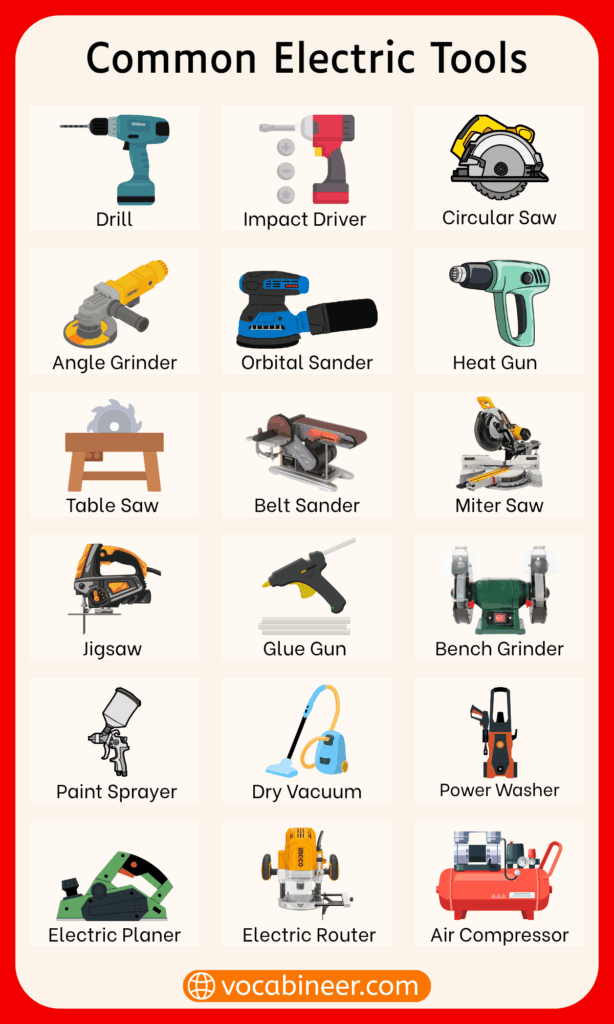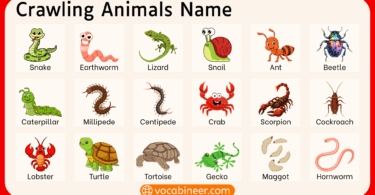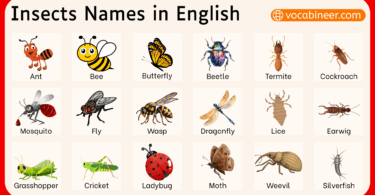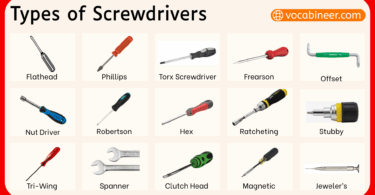Electrical tools are items used to fix, check, or install wires, circuits, and devices. These tools help electricians and learners handle electric work safely and correctly. In this post, you’ll find a full list of electrical tools names in English with pictures. Each tool name is shown with a simple description to support spelling, usage, and meaning. This topic is useful for students, ESL learners, and trade vocabulary building.
In This Page
What Are Electrical Tools?
Electrical tools are used to install, repair, test, or protect wires, devices, and circuits. These tools are important for both home repairs and professional electrical work. Each tool has a specific job, such as cutting wires, checking voltage, or joining connections. In this post, you’ll learn 50 electrical tools names in English with pictures to help you build strong vocabulary and understand their uses clearly.
Common Electrical Tools Names with Pictures
These are the most commonly used electrical tools in homes, schools, and construction sites. The tools are grouped by how they help in measuring, cutting, gripping, fastening, joining, or protecting during electrical work. Each tool name is shown with a short description and picture to support word-picture learning.
Measuring Tools Used by Electricians
- Multimeter: Measures voltage, current, and resistance with different settings. It’s used to test electronic circuits and batteries.
- Clamp Meter: Measures current by clamping around a wire without breaking the circuit. Handy for electricians working with live systems.
- Voltage Tester: Checks if electrical current is present in outlets or wires. Often used before doing any repair work.
- Insulation Tester: Tests the insulation strength of wires or cables. Helps find faults in old or damaged wiring by applying high voltage.
Cutting and Stripping Electrical Tools
- Wire Cutter – Cuts electric wires cleanly
- Cable Stripper – Removes insulation from cables
- Hacksaw – Used to cut metal conduits or plastic pipes
- Utility Knife – For trimming and cutting materials
Pliers and Gripping Tools in Electrical Work
- Needle Nose Pliers: Used to bend and hold small wires or reach tight spots. Great for precision electrical work and repairs.
- Lineman’s Pliers: These can cut, twist, and grip thick wires. Electricians use them for both installation and heavy-duty work.
- Combination Pliers: Designed for both gripping and cutting tasks. Useful for handling medium-sized wires or general repairs.
- Slip Joint Pliers: Feature an adjustable pivot point. They fit different sizes and are used for multiple electrical and mechanical jobs.
Driving and Fastening Tools for Electrical Jobs
- Screwdriver Set – For tightening or loosening screws
- Nut Driver – Turns nuts and bolts easily
- Electric Drill – Makes holes for wiring and fasteners
- Power Screwdriver – Speeds up screw fastening
Soldering and Joining Tools
- Soldering Iron – Joins wires with melted solder
- Solder Wire – Filler metal for soldering
- Heat Gun – Shrinks insulation or softens glue
- Wire Connector – Joins multiple wires safely
Safety Tools Used in Electrical Work
- Insulated Gloves – Protect hands from electric shock
- Safety Goggles – Shields eyes from sparks or dust
- Voltage Detector Pen – Detects live current without contact
- Rubber Mat – Prevents current from reaching your body
Testing and Diagnostic Tools
- Circuit Tester – Checks if a circuit works
- Continuity Tester – Checks wire path from end to end
- Phase Tester – Identifies electrical phase in a circuit
- Earth Resistance Tester – Measures ground resistance

Electrical Tools Names by Category
Grouping electrical tools by category helps learners understand how each tool is used in different tasks. Below are the main types of tools electricians use, sorted by purpose and function.
Hand Tools Used in Electrical Work
These tools are operated by hand and are essential for basic wiring, cutting, and gripping tasks.
- Screwdriver Set
- Wire Cutter
- Needle Nose Pliers
- Cable Stripper
- Utility Knife
- Lineman’s Pliers
Power Tools for Electrical Repair and Setup
These tools use electric power to perform tasks more quickly and with less effort.
- Electric Drill
- Power Screwdriver
- Heat Gun
- Cable Tie Gun
Measuring and Testing Tools
Used to check voltage, resistance, connection, or grounding, these tools support safety and accuracy.
- Multimeter
- Clamp Meter
- Voltage Tester
- Continuity Tester
- Earth Resistance Tester
- Phase Tester
Safety and Personal Protective Equipment (PPE)
These tools and items protect workers from electric shock, sparks, or short circuits.
- Insulated Gloves
- Safety Goggles
- Voltage Detector Pen
- Rubber Mat
- Headlamp
Soldering and Joining Tools
Used to connect wires, terminals, or components safely and permanently.
- Soldering Iron
- Solder Wire
- Wire Connector
- Wire Crimper
- Splicing Connector
Storage, Organizing, and Pulling Tools
These help manage cables, wire routing, and tool transport efficiently.
- Electrical Fish Tape
- Label Maker
- Electrician’s Belt
- Wire Reel Stand
Full List of 50 Electrical Tools with their Uses
| Tool Name | Type | Use or Function |
|---|---|---|
| Multimeter | Measuring | Checks voltage, current, resistance |
| Clamp Meter | Measuring | Measures current safely |
| Voltage Tester | Measuring | Detects electricity |
| Insulation Tester | Measuring | Tests insulation resistance |
| Wire Cutter | Cutting | Cuts electric wires |
| Cable Stripper | Cutting | Removes insulation from wire |
| Hacksaw | Cutting | Cuts pipes or conduits |
| Utility Knife | Cutting | Cuts sheets, wires, etc. |
| Needle Nose Pliers | Gripping | Bends and holds small wires |
| Lineman’s Pliers | Gripping | Cuts, grips, and twists wires |
| Combination Pliers | Gripping | Multi-purpose pliers |
| Slip Joint Pliers | Gripping | Adjustable for different tasks |
| Screwdriver Set | Fastening | Screws and unscrews parts |
| Nut Driver | Fastening | Tightens nuts and bolts |
| Electric Drill | Power Tool | Makes holes in surfaces |
| Power Screwdriver | Power Tool | Speeds up screw work |
| Soldering Iron | Joining | Joins wires with solder |
| Solder Wire | Joining | Filler for soldering |
| Heat Gun | Joining | Shrinks insulation, melts glue |
| Wire Connector | Joining | Connects multiple wires |
| Insulated Gloves | Safety | Protects from electric shock |
| Safety Goggles | Safety | Eye protection |
| Voltage Detector Pen | Safety | Contactless voltage testing |
| Rubber Mat | Safety | Non-conductive floor surface |
| Circuit Tester | Diagnostic | Checks current in a circuit |
| Continuity Tester | Diagnostic | Confirms connection path |
| Phase Tester | Diagnostic | Detects electrical phase |
| Earth Resistance Tester | Diagnostic | Measures grounding |
| Wire Crimper | Joining | Crimps terminals onto wires |
| Cable Tie Gun | Organizing | Tightens and cuts cable ties |
| Wire Tracker | Diagnostic | Traces cable lines |
| Digital Caliper | Measuring | Measures precise dimensions |
| PVC Pipe Cutter | Cutting | Cuts plastic conduit |
| Electrical Fish Tape | Pulling | Pulls wire through conduit |
| Punch Down Tool | Networking | Connects wires to panels |
| Splicing Connector | Joining | Links wires without twisting |
| Flashlight | Safety | Lighting during work |
| Label Maker | Organizing | Tags wires and cables |
| Conduit Bender | Bending | Bends metal/plastic conduit |
| Cable Lugs | Termination | Connects wires to devices |
| Insulation Tape | Safety | Wraps exposed wires |
| Electrical Tester Pen | Diagnostic | Simple voltage detection |
| Wire Brush | Cleaning | Cleans terminal surfaces |
| Battery Tester | Diagnostic | Checks charge level |
| Wire Reel Stand | Storage | Holds heavy cable reels |
| Thermographic Camera | Diagnostic | Detects heat in circuits |
| Laser Distance Meter | Measuring | Measures cable path lengths |
| Headlamp | Safety | Hands-free lighting |
| Electrician’s Belt | Storage | Carries tools around the waist |
FAQs about Electrical Tools
Common ones include multimeter, wire cutter, screwdriver, and soldering iron.
Safe tools include insulated screwdrivers, testers, gloves, and wire strippers.
Use picture-based lists, label practice, and real-world examples during study.
Most basic tools are the same, but voltage testers and safety standards may differ.
Read More




